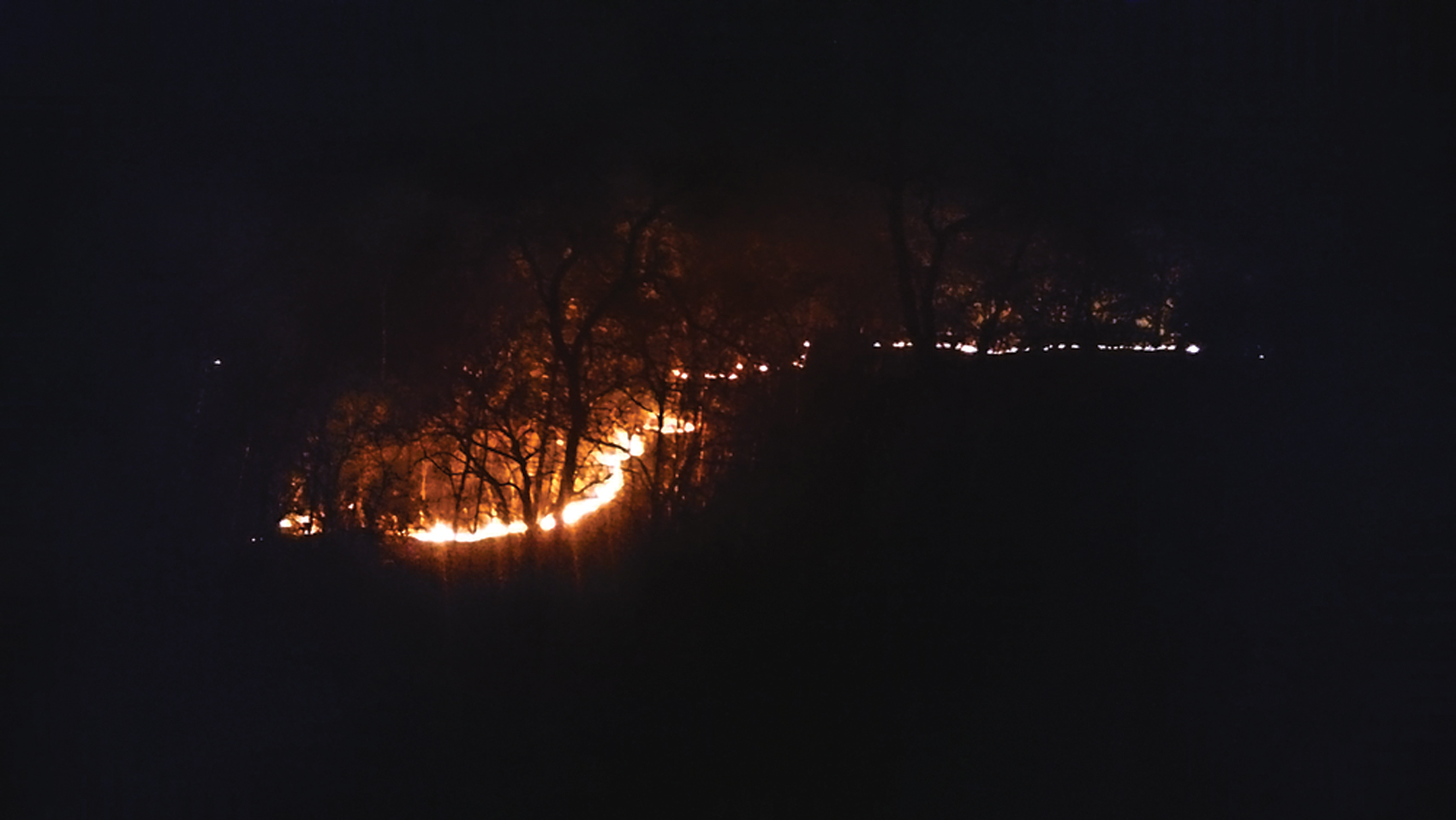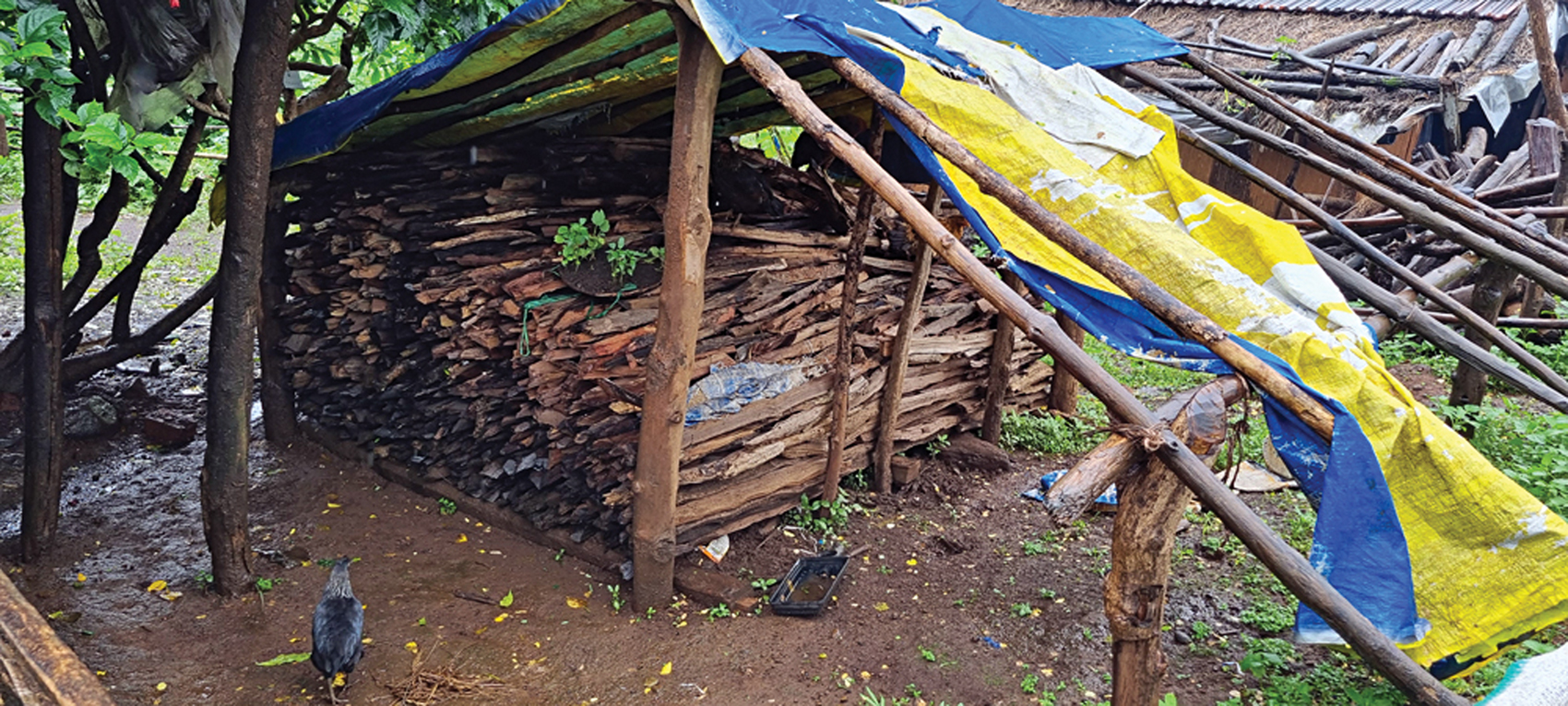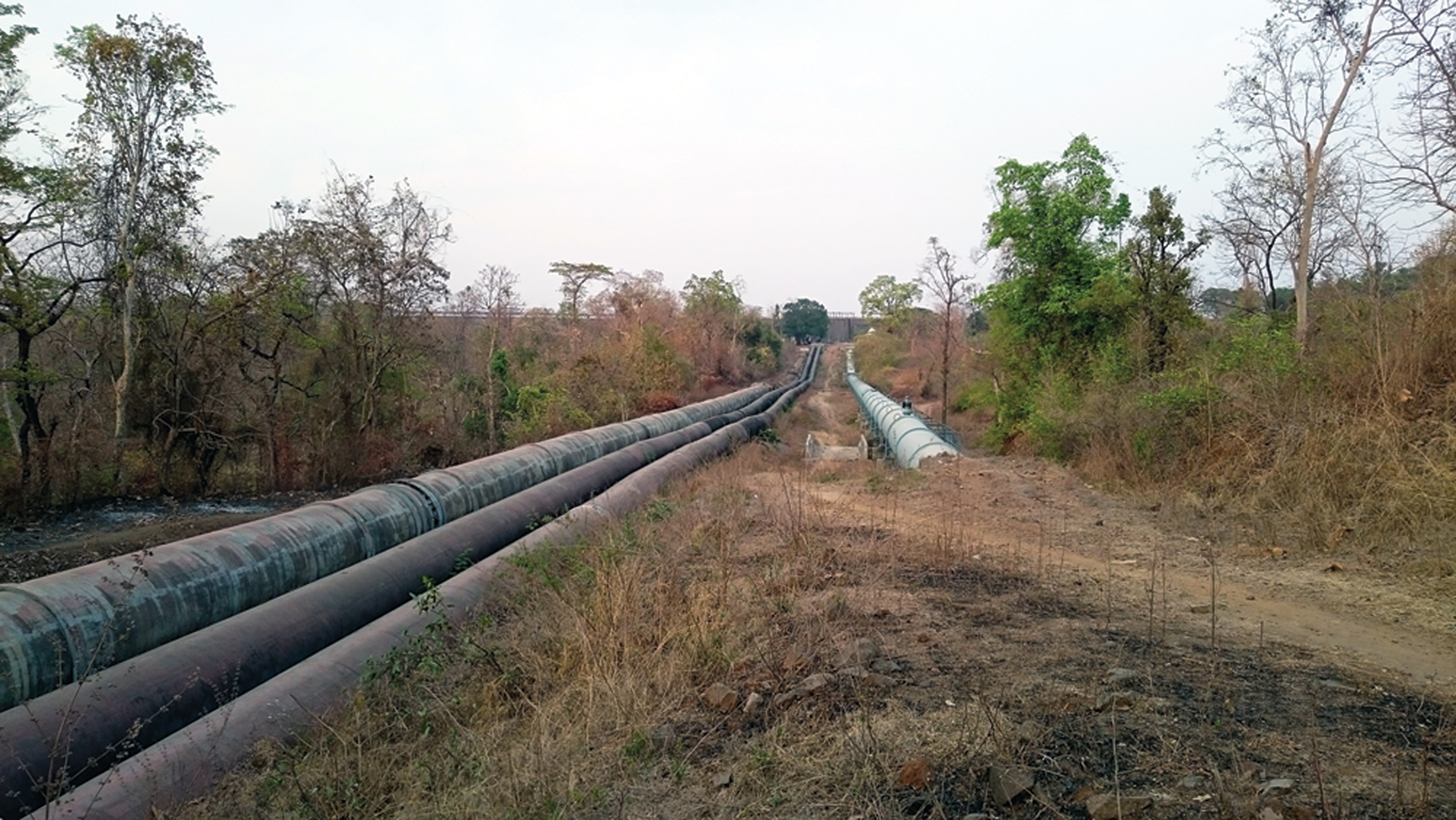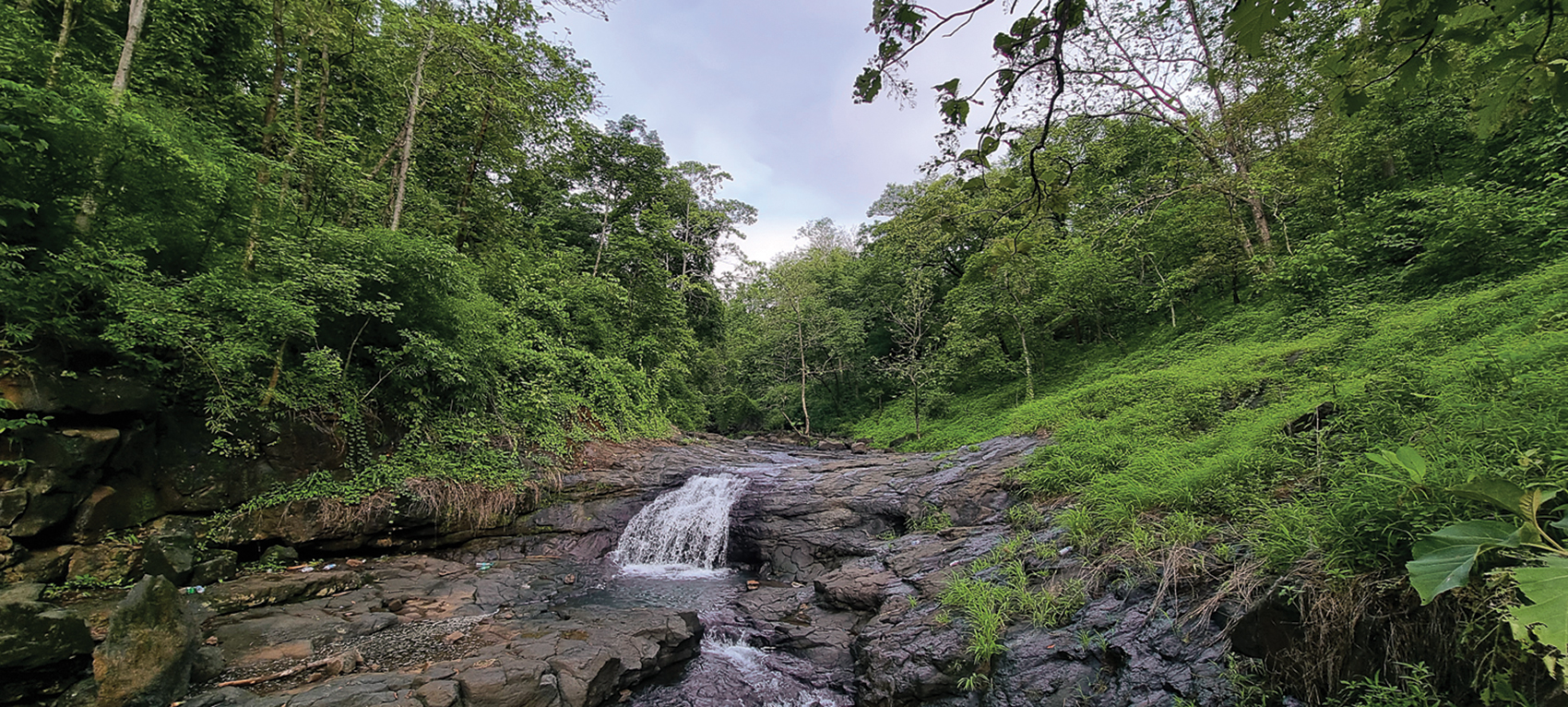Tansa: A Forgotten Forest Paradise
First published in Sanctuary Asia,
Vol. 41
No. 12,
December 2021
By Kedar Gore
In the summer of 1995, I made my first trip to the Tansa Wildlife Sanctuary near Mumbai, as a naturalist for a group of curious kids. The beauty of this deciduous forest with a few patches of semi-evergreen interspersed by river valleys had me spellbound. The log hut atop a hillock near Tansa Dam was our camping site for a few days. Nights were spent on the huge veranda. There was no electricity and sleeping in the open provided some respite from the humid weather. Barking deer regularly arrived to feed on the mahua Madhuca latifolia flowers behind the log hut. Leopard tracks were often seen during nature walks. It wasn’t known then that the Tansa Wildlife Sanctuary was one of the western most limits for the endangered and endemic Forest Owlet. I visited Tansa often while leading Bombay Natural History Society (BNHS) and WWF-India’s nature education camps. It was a wildlife-rich destination then, but over the years, tree cutting, hunting, uncontrolled forest fires and encroachments have greatly degraded the landscape.
The Tansa forest is contiguous with the forested areas of Thane, Palghar and Nashik and also has connectivity with the Kalsubai Harishchandragad Wildlife Sanctuary and the Thane Forest Division. From here it connects to the Bhimashankar Wildlife Sanctuary, Tungareshwar Wildlife Sanctuary and Sanjay Gandhi National Park, Wada and Jawhar Forest Divisions. It’s not a ‘mere forest’! Tansa is a vital catchment for the Vaitarna, Tansa and Gargai rivers, all lifelines for local communities and wildlife. Gargai, a tributary of the Vaitarna river, flows through the northern part of the sanctuary eventually meeting the Pinjal river around 10 km. away from the northwestern boundary of the sanctuary.

The forested landscape of Tansa is fragmented by villages and tribal hamlets throughout its expanse. Fires lit for traditional raab farming, or deliberately set to facilitate bushmeat hunting often spread out of control in the dry season. Local communities are also highly dependent on the forest for fuelwood, leading to habitat degradation.
Photo:Kedar Gore
CONSERVATION CHALLENGES Like other Protected Areas, the Tansa Wildlife Sanctuary has had its share of conservation challenges. For several years, the forest has been exploited for teak Tectona grandis and khair Acacia catechu to feed timber and gutka (a preparation of tobacco) markets, respectively. Saw mills abound within the Eco Sensitive Zone, some within the sanctuary itself. Efforts to stop this illegal activity by the Forest Department over the years have been stymied by mafias operating for decades with unseemly political protection.
The forest landscape of Tansa is fragmented by villages and tribal hamlets throughout its expanse. The local communities, mostly tribals, subsist mainly on paddy cultivation. In many areas, this has resulted in forests being re-categorised as agricultural land under the Forest Rights Act, 2006. Fires lit for traditional raab farming, or deliberately set to facilitate bush meat hunting often spread out of control in the dry season. Large swathes of charred land are common sights in summer. A high dependency of local communities on fuelwood speeds up habitat deterioration. An assessment by The Corbett Foundation (TCF) put the fuelwood consumption in the Khardi Range to around 2.3 tonnes annually for just one household with an average family size of five to seven individuals. LPG gas cylinder distribution, availability and affordability are impediments, as in many other forested landscapes in India.
Hunting of wildlife by local communities, for the pot and for the illicit wildlife trade, is an important threat that is seldom highlighted. Tansa is now almost bereft of sambar, barking deer, four-horned antelope and many other species. The Indian giant squirrel (the state animal of Maharashtra), once common in the sanctuary, is now rarely seen; thanks to poaching and habitat loss. Forest cover and the hilly terrain, combined with plentiful water, has encouraged large herds of livestock and this too has played a role in edging out the wild herbivores in this forest.
Unemployment among youth is rampant leaving these young men and women heavily dependent on the forest for their subsistence and livelihood. The COVID-19 pandemic has further exacerbated the situation. It is high time that the Forest Department engages these youth into a meaningful dialogue, and involve them in conservation programmes that raise awareness and generate long-term, sustainable, respectful livelihoods. The presence of community-owned dogs is also a matter of grave concern given the significant threat they pose to wild birds and mammals. The current population of leopards in the sanctuary is unknown, but attacks on livestock and village dogs by leopards at the base of the Suryamal Hill are not uncommon. It would not be far-fetched to draw a link between the several cases of leopard poaching unearthed and investigated by the Forest Department around Mumbai and the absence of these large cats from such a promising forested landscape! One of the rarest birds, once thought to be extinct, the Forest Owlet, is known to avoid the areas degraded by over-grazing. And then we have the problem of disease transmission from domestic livestock to remaining wild herbivores.

An assessment by The Corbett Foundation (TCF) found the fuelwood consumption in the Khardi Range to be around 2.3 tonnes annually for just one household with an average family size of five to seven individuals. LPG gas cylinder distribution, availability and affordability are impediments, as in many other parts of the country.
Photo:Kedar Gore
_MG_2909_SWPA2021_C-1700_1638533316.jpg) The Forest Owlet was thought to be extinct until it was rediscovered in 1997 in the Tansa Wildlife Sanctuary by naturalists from the Bombay Natural History Society (BNHS), making it the first sighting of the bird in the Western Ghats.
The Forest Owlet was thought to be extinct until it was rediscovered in 1997 in the Tansa Wildlife Sanctuary by naturalists from the Bombay Natural History Society (BNHS), making it the first sighting of the bird in the Western Ghats.
Photo:Mehul Patel
Rich in Biodiversity
The Tansa Wildlife Sanctuary is spread over 320 sq. km. in Thane and Palghar districts of Maharashtra. The terrain is mainly hilly, with Suryamal Hill in Palghar district towards the northeast and Mahuli hill in Thane district at the south end of the sanctuary. In 1986, two tigers were sighted near Suryamal by local tribals and Forest Department staff. Recognising the ecological significance of Tansa, an Eco Sensitive Zone (ESZ) of 625 sq. km. around the sanctuary, covering 145 villages in Shahapur, Bhiwandi, Mokhada and Wada tehsils, has been notified.
A part of the northern Western Ghats, Tansa forest is a treasure trove of biodiversity. Teak
Tectona grandis is the dominant tree species here. Other trees include small, flowered crape myrtle
Lagerstroemia parviflora, Indian laurel
Terminalia tomentosa, black catechu
Acacia catechu, true kadamba
Mitragyna parvifolia, haldu
Adina cordifolia, red silk cotton
Bombax ceiba, karmal
Dillenia pentagyna, axlewood
Anogeissus latifolia and others. In 2011, long-tailed habenaria
Habenaria longicorniculata, an orchid species endemic to India, was recorded from Mahuli Fort by a team of botanists from
St. Xavier’s College, Mumbai.
A survey done by the Zoological Survey of India (ZSI) in Tansa in 1992 revealed the presence of over 50 species of mammals including the leopard, Indian chevrotain, sambar, leopard cat, rusty-spotted cat, Indian porcupine, ruddy mongoose, small Indian civet, striped hyena and Indian pangolin among others. The ZSI recommended Tansa to be declared as a sanctuary to protect the four-horned antelope that has a restricted distribution in the Western Ghats.
The freshwater crocodile is found in the Vaitarna river that flows through the sanctuary. Indian python, Indian cobra, bamboo pit viper, common monitor and Indian chameleon are some of the commonly occurring reptiles. With 212 species of avifauna recorded, the Tansa Wildlife Sanctuary has been included as an Important Bird Area since 2004 by the BNHS. The late Dr. Sálim Ali and late Humayun Abdulali, both of whom have done seminal work in documenting the avifauna of India, have recorded White-bellied Woodpecker, Heart-spotted Woodpecker and Oriental Dwarf Kingfisher around the Suryamal Hill in the 1940s and 1950s. Critically Endangered White-rumped Vulture and Indian Vulture, and endangered Pallas’s Fish Eagle have also been recorded here. The Forest Owlet was first reported from Tansa in October 2014 by researchers Sunil Laad and Rohidas Dagale. Subsequent surveys by BNHS and Wildlife Research and Conservation Society revealed patchy distribution of the species in all the four ranges of the sanctuary, namely Tansa, Khardi, Vaitarna and Parali.
THREATS TO TANSA'S FUTURE The litany of Tansa’s woes does not stop here. Now a huge dam threatens the very existence of Tansa’s finest forest range, Parali. Three large dams have been already built over the Vaitarna river – Upper Vaitarna, Middle Vaitarna and Modak Sagar. The last one drowned parts of the Tansa Wildlife Sanctuary. The Tansa Dam, built over the Tansa river, also flows through the sanctuary. The administrative control of these dams lies with the Municipal Corporation of Greater Mumbai (MCGM), not the Forest Department. The MCGM plans to construct yet another dam inside the sanctuary with a storage capacity of 440 MLD on the Gargai river to augment Mumbai’s never-ending thirst for water, which will submerge around 720 ha. of forest affecting six villages Ogade, Khodade, Tilmal, Pachghar, Fanasgaon and Amale in Parali Range. In March 2013, this dam project was opposed by the Standing Committee, National Board for Wildlife and by several conservationists but despite all manners of articulations on the need to protect our forest by policy makers, this hugely destructive dam project is still on the anvil. An astounding 5,00,000 trees would be lost if the Gargai Dam is constructed. And then we have yet another, larger dam of 865 MLD capacity proposed on the Pinjal river, just 10 km. away. This will destroy 1,130 ha. of forests, contiguous to the Tansa Wildlife Sanctuary.
A Rapid Biodiversity Assessment conducted in July 2021 by TCF, for the Thane Wildlife Division, documented over 400 species of flora, fungi and fauna in ~330 ha. of the proposed submergence area of the Gargai Dam. This is just a glimpse of the rich biodiversity this sanctuary harbours. With so many new species and genera being discovered in the northern Western Ghats, a long-term biodiversity survey of the Tansa Wildlife Sanctuary is desperately needed.

The litany of Tansa’s woes is never ending. Now a huge dam threatens the very existence of its finest forest range, Parali. Three large dams have already been built over the Vaitarna river, and the Tansa Dam was built over the Tansa river. The Municipal Corporation of Greater Mumbai (MCGM), plans to construct yet another dam inside the sanctuary on the Gargai river to augment Mumbai’s never-ending thirst for water, which will submerge around 720 ha. of forest and affect six villages.
Photo:Kedar Gore
The plethora of problems faced by Tansa and its connected forests defies reason. It is now common knowledge that the natural ecosystems that used to be treated as impediments to infrastructure development, were actually the most vital infrastructure in their own rights. India is one of the world’s largest dam builders despite their known disastrous ecological impacts on local communities, geology, forests and wildlife populations. The National Institute for Space Research, Brazil calculates that the world’s largest dams built by drowning tropical forests in Asia, Africa and South America annually emitted 104 million tons of methane, one of the most dangerous greenhouse gases, and have been responsible for four per cent of the human contribution to climate change. I wonder if such devastating impacts of Gargai and Pinjal dams have even been thought through by the MCGM. Compensatory afforestation programmes are often promoted in lieu of the trees cut for such developmental projects. However, any such programme, if being considered, will prove to be futile because such plantations have never successfully replaced forests evolved over hundreds of years and the ecosystem services they provide.
Given the ecological importance of the Tansa Wildlife Sanctuary, constructing yet another dam would be pointless. Too much ecological damage has already been done to Mumbai’s hinterland. We not merely need a moratorium on the construction of any further large dams in Maharashtra, but need to work on restoring catchment forests, using nature-based solutions that secure our future. This is not to say that no engineering solutions are required. We need budgets and systems to prevent the 20-25 per cent water leakage/theft that has become the norm. This little-spoken-about tragedy amounts to around 800-1000 MLD, twice the anticipated water storage capacity of Gargai Dam!

Compensatory afforestation programmes are often promoted in lieu of the trees cut for developmental projects in forested areas. However, any such programme, if being considered, will prove to be futile because such plantations have never successfully replaced forests evolved over hundreds of years and the ecosystem services they provide.
Photo:Kedar Gore
Halting water leakages, wasteful consumption, pilferage and misuse of the precious fresh water could boost Maharashtra’s economy far more effectively than wasting good money on dams. Every rooftop in urban Maharashtra should be a rainwater harvesting device. Our engineering minds should work on sustainable solutions to economise the use of fresh water in the city and look at other alternatives.
In conclusion, if Tansa continues to be as ill-treated as it has been over decades, it would be just a matter of time that this beautiful forest is lost forever. Tansa Wildlife Sanctuary and surrounding forests are not merely ‘large water storage tanks’ for Mumbai. These forests are crucial for climate moderation, stocking aquifers, keeping viruses in check and sequestering and storing carbon. They have biodiversity values and ecosystem services whose worth as economic, ecological, social and survival assets could well be lost forever if we do not wake up and change our business-as-usual attitude.




_MG_2909_SWPA2021_C-1700_1638533316.jpg)

